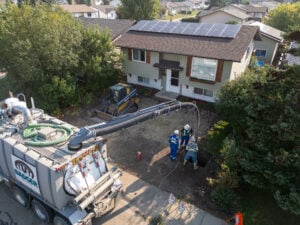Heat pumps
Heat pumps are becoming increasingly popular for families looking to upgrade or invest in their home heating and cooling systems. These devices pull heat from outside, pump it into your home in the winter, extract heat from inside your house, and send it outside in the summer. They are two to five times more efficient than gas furnaces and provide substantial savings on energy bills. According to an Ontario Clean Air Alliance report, Ontarians with a gas furnace and air conditioner, for example, can save $1,000 or more per year by switching to an air-source heat pump. It is thus unsurprising that most of the Live Net Zero families chose to invest in or upgrade this system.
When the Reid household conducted their Home Energy Audit, it included a new heat pump as a recommended upgrade. “We kind of ignored that initially,” the family said. “Why spend that kind of money, even with the healthy rebate it comes with, if you already have a functioning heat pump?”
The answer, they concluded, ended up being a blend of efficiency and divestment. Though they had a heat pump that was only 12 years old, they learned that replacing them would be more energy efficient. Following the installation of their new pump, they saw changes almost immediately.
“We’re noticing it has more force in the house,” Jen Reid explained. “We’re noticing we’re more comfortable.” They noted that for heat pumps to be effective, one must have a well-sealed building envelope – the focus for challenge two.
Meanwhile, the MacInnis-Boudreau family has discovered that while heat pumps blow warm air almost instantaneously, the warm air can dissipate very quickly once turned off. This is in contrast to more “traditional” devices, such as radiators, which tend to hold heat for hours after they’ve been turned on.
“We definitely learned the value of finding our sweet spot [and] the importance of keeping them running more constantly,” Ashley MacInnis said, explaining that turning the pump on and off is less efficient as it uses more energy.












